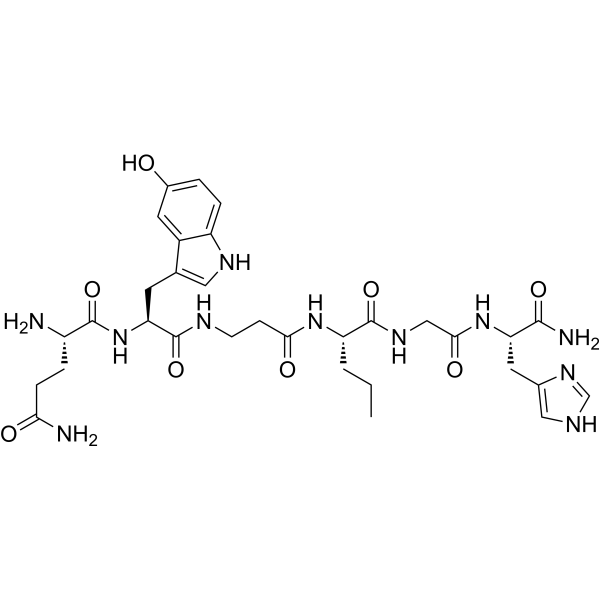GB-6
Modify Date: 2025-08-25 06:36:56

GB-6 structure
|
Common Name | GB-6 | ||
|---|---|---|---|---|
| CAS Number | 2413262-74-3 | Molecular Weight | 711.77 | |
| Density | N/A | Boiling Point | N/A | |
| Molecular Formula | C32H45N11O8 | Melting Point | N/A | |
| MSDS | N/A | Flash Point | N/A | |
Use of GB-6GB-6 is a short linear peptide that targets the gastrin releasing peptide receptor (GRPR). GRPR is overexpressed in pancreatic cancer. Based on the tumor selectivity and tumor-specific accumulation properties of GB-6, GB-6 labeled with near infrared (NIR) fluorescent dyes or radionuclide netium-99m (99mTc) can be used as a high-contrast imaging probe. GB-6 has excellent in vivo stability, with tumor to pancreatic and intestinal fluorescence signal ratios of 5.2 and 6.3, respectively, in SW199 0 subcutaneous xenograft models. GB-6 can rapidly target tumors and accurately delineate tumor boundaries, which has broad application prospects[1]. |
| Name | GB-6 |
|---|
| Description | GB-6 is a short linear peptide that targets the gastrin releasing peptide receptor (GRPR). GRPR is overexpressed in pancreatic cancer. Based on the tumor selectivity and tumor-specific accumulation properties of GB-6, GB-6 labeled with near infrared (NIR) fluorescent dyes or radionuclide netium-99m (99mTc) can be used as a high-contrast imaging probe. GB-6 has excellent in vivo stability, with tumor to pancreatic and intestinal fluorescence signal ratios of 5.2 and 6.3, respectively, in SW199 0 subcutaneous xenograft models. GB-6 can rapidly target tumors and accurately delineate tumor boundaries, which has broad application prospects[1]. |
|---|---|
| Related Catalog | |
| Target |
Gastrin releasing peptide receptor (GRPR)[1] |
| References |
| Molecular Formula | C32H45N11O8 |
|---|---|
| Molecular Weight | 711.77 |
| InChIKey | MRBDDQRPZZFCHW-LFBFJMOVSA-N |
| SMILES | CCCC(NC(=O)CCNC(=O)C(Cc1c[nH]c2ccc(O)cc12)NC(=O)C(N)CCC(N)=O)C(=O)NCC(=O)NC(Cc1cnc[nH]1)C(N)=O |